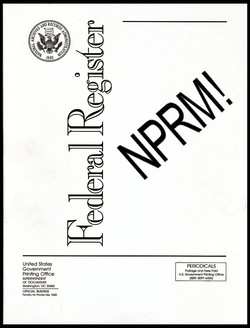Issue Will Be Revisited, But For Now, Proposed Rule Is "Out Of
Date"
 The FAA announced Tuesday it is
withdrawing a previously published NPRM that proposed to establish
one set of duty period limitations, flight time limitations, and
rest requirements for flight crewmembers engaged in air
transportation. The NPRM also proposed to establish consistent and
clear duty period limitations, flight time limitations, and rest
requirements for domestic, flag, supplemental, commuter and
on-demand operations.
The FAA announced Tuesday it is
withdrawing a previously published NPRM that proposed to establish
one set of duty period limitations, flight time limitations, and
rest requirements for flight crewmembers engaged in air
transportation. The NPRM also proposed to establish consistent and
clear duty period limitations, flight time limitations, and rest
requirements for domestic, flag, supplemental, commuter and
on-demand operations.
The notice or withdrawal, published in the Federal Register,
said the administration is taking the action because the NPRM is
outdated, and because of the many significant issues commenters
raised. The FAA intends to issue a new NPRM to address flight,
duty, and rest.
The proposed NPRM was first drafted 17 years ago by the Aviation
Rulemaking Advisory Committee (ARAC) Flight Crewmember
Flight/Duty Rest Requirements working group. The notice was first
published back in 1995. The proposed rule was based on proposals
from the ARAC working group, the petitions for rulemaking from the
industry and others, National Transportation Safety Board (NTSB)
recommendations, and existing knowledge of fatigue, including
research by the National Aeronautics and Space Administration
(NASA). Subsequently, and in response to requests from the
industry, the FAA extended the comment period closing date and
answered clarifying questions to the NPRM in a 1996 notice
published in the Federal Register.
 Over 2000 comments were received.
Although some commenters, including the NTSB, NASA, Air Line Pilots
Association, and Allied Pilots Association, said the proposal would
enhance safety, the same commenters had specific objections. For
example, the pilot unions objected to the proposed increase in
allowed flight time. These commenters also said the proposal should
have included special duty and flight time limits for disruptions
in circadian rhythm and for operations with multiple takeoffs and
landings. Many industry associations opposed the NPRM, stating the
FAA lacked safety data to justify the rulemaking, and industry
compliance would impose significant costs. Since 2001, the agency has undertaken other
fatigue mitigation efforts. Among these efforts was the Part
125/135 Aviation Rulemaking Committee (ARC),7 which was convened in
February 2003, to do a comprehensive regulatory review of rules on
flight, duty, and rest. The ARC submitted its recommendations in
September 2005.
Over 2000 comments were received.
Although some commenters, including the NTSB, NASA, Air Line Pilots
Association, and Allied Pilots Association, said the proposal would
enhance safety, the same commenters had specific objections. For
example, the pilot unions objected to the proposed increase in
allowed flight time. These commenters also said the proposal should
have included special duty and flight time limits for disruptions
in circadian rhythm and for operations with multiple takeoffs and
landings. Many industry associations opposed the NPRM, stating the
FAA lacked safety data to justify the rulemaking, and industry
compliance would impose significant costs. Since 2001, the agency has undertaken other
fatigue mitigation efforts. Among these efforts was the Part
125/135 Aviation Rulemaking Committee (ARC),7 which was convened in
February 2003, to do a comprehensive regulatory review of rules on
flight, duty, and rest. The ARC submitted its recommendations in
September 2005.
Also, in June 2008, FAA held an Aviation Fatigue Management
Symposium 8 that provided the industry with the latest information
on fatigue science, mitigation, and management. Currently, the
agency is developing an Advisory Circular on fatigue that
incorporates information from the Symposium. Additionally, in June
2009, the FAA chartered the Flight and Duty Time Limitations and
Rest Requirements ARC9 comprised of labor, industry, and FAA
representatives to develop recommendations for an FAA rule based on
current fatigue science and a thorough review of international
approaches to the issue.
Given all that history, the FAA is withdrawing the 1995 Flight
Crewmember Duty Period Limitations, Flight Time Limitations and
Rest Requirements NPRM because it is outdated and because it raised
many significant issues that the agency needed to consider before
proceeding with a final rule. Instead of adopting the provisions of
the 1995 NPRM, the FAA intends to develop a new NPRM later this
year that considers the Flight and Duty Time Limitations and Rest
Requirements ARC recommendations, scientific research, NTSB
recommendations on fatigue and flight duty time, and the
recommendations of the Part 125/135 ARC.
 ANN's Daily Aero-Term (04.20.24): Light Gun
ANN's Daily Aero-Term (04.20.24): Light Gun Aero-News: Quote of the Day (04.20.24)
Aero-News: Quote of the Day (04.20.24) ANN's Daily Aero-Linx (04.21.24)
ANN's Daily Aero-Linx (04.21.24) Aero-News: Quote of the Day (04.21.24)
Aero-News: Quote of the Day (04.21.24) ANN's Daily Aero-Term (04.21.24): Aircraft Conflict
ANN's Daily Aero-Term (04.21.24): Aircraft Conflict




